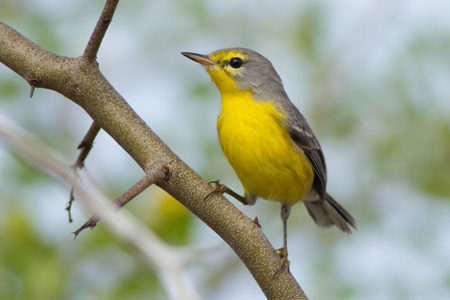
March 28th, 2019: A year and a half after Category 5 Hurricane Irma smashed into the beautiful island of Barbuda. A survey team is on the local ferry, returning to conduct follow-up population assessments of the endemic Barbuda Warbler and the Magnificent Frigatebird colony. The Barbuda Warbler was last evaluated by the IUCN in October, 2016 and was classified as Near Threatened; the Magnificent Frigatebird colony is the largest breeding colony in the western hemisphere. As an endemic, the Barbuda Warbler is completely restricted to the 62 square mile island and with its relatively small population, is at a higher risk from extreme weather events and habitat loss. The frigatebird colony as the largest breeding colony in the region is critical to the continued success of this species in the Atlantic. When Hurricane Irma swept over the island, we feared for the safety of both the Barbuda Warbler and the frigatebird breeding colony. An assessment team was quickly gathered and sent to assess both species in October 2017. We found that the Barbuda Warbler seemed to have survived the hurricane well and the Magnificent Frigatebirds were already started to return in numbers. But, we were returning to investigate: how were these populations both doing 18 months later?
Of Tents, Tarps, and Old Friends
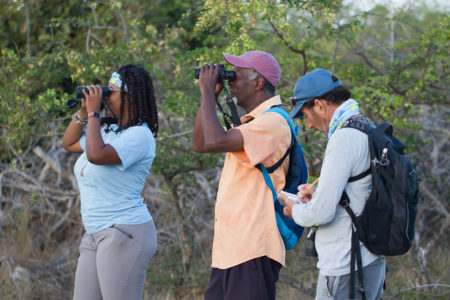
Immediately upon landing at the ferry docks, we were greeted by the faces of friends we had made on the previous visit. Kelly Burton, Codrington Lagoon National Park Manager (Dept of Environment), was there making sure that the arrangements for transportation, food and lodging were taken care of and that our sometimes ‘unusual’ needs were met. Once we settled into our lodgings, we had a quick look around the town of Codrington, which had been nearly destroyed by the hurricane. Many homes now have electricity and roofs, but many were still without the basic needs of a simple roof. Tents and tarps are still being used by many Barbudans. Before we even left Codrington for an initial training session on methods, we encountered several Barbuda Warblers and the local subspecies of Yellow Warbler. A good sign for the first day.
We then headed north towards Two Foot Bay, where Jeff Gerbracht and Fernando Simal from BirdsCaribbean oriented the rest of the team with the survey methodology and what to expect for the following week: early mornings, late evenings and lots of walking, counting birds and good company!! Natalya Lawrence (Environmental Awareness Group – EAG), Sophia Steele (Flora & Fauna International) and Joseph (Junior) Prosper (EAG) enthusiastically dove right into the methods, asking great questions about the survey forms and practicing the count protocol. Sophia was part of the field team just after Irma and her prior experience with the methods was an added bonus. Of the eight point counts made that first afternoon, only one didn’t include a Barbuda Warbler, again a great start to a great week.
Revisiting Old Haunts, Meeting the Barbudans, and Lobster Wraps for Lunch
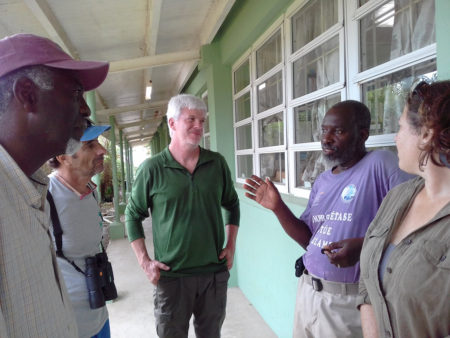
The next day started with sunrise, with two teams visiting the points we had sampled a year and a half earlier. Generally, each team was able to cover 8-15 points before the sun drove both us and the warblers into hiding. We looked forward to the lunch breaks with fantastic lobster wraps provided by Claudette and the occasional visits by her lovely granddaughter. After a relaxing lunch and brief rest, we were back in the field by 3pm, covering as many points as possible before sunset. Evenings were a group dinner, followed by a few Wadadlis (local beer!) and strategizing for the following day.
One of the biggest differences from my prior visit was the number of people that were back on the island. During our first visit, Codrington was almost deserted, and this time it was a vibrant community. This also meant we could meet with the community members, discuss what we were doing and why, and also begin to understand their lives and challenges post-Irma. We met with the principals of both schools, gave presentations on the Barbuda Warbler and the monitoring efforts to several of the classes, and had many enlightening discussions with Barbudans we would meet in and around town. Several times during the week we met children returning home from school, which often resulted in some impromptu birding classes.
The Frigatebird Revival
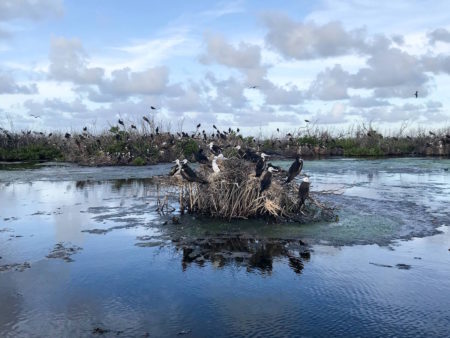
Partway through the week, Natalya and Sophia had to return to Antigua and Shanna Challenger (Flora and Fauna International), also an alum from the first season, joined the field crew and quickly showed her talent for spotting hard to find birds. With the help of Shanna and Joseph (who walked more miles than any of us), we were able to complete the necessary point counts, which gave us some extra time to conduct a rapid count of the Magnificent Frigatebird colony in the Codrington Lagoon NP. An afternoon boat trip to the colony was spectacular. We were joined by additional EAG staff (Nathan Wilson) and we counted as much of the colony as possible. One person counted adults, a second counted downy chicks and a third counted the ‘white-headed’ birds (mostly birds hatched either last year or very early this year). We counted a whopping 7,451 frigatebirds. The mangroves appear to be recovering slowly but that didn’t seem to bother the frigatebirds too much.
Connecting with Barbudans of All Ages
One of the very important aspects of our trip, besides counting the birds of course, was interacting with the Barbudans. During the second half of the trip, a team from EAG traveled from Antigua to do just that. In addition to the visits that we had already made to both schools, Arica Hill, EAG’s Executive Director, led the charge to host Barbuda Warbler presentations at the elementary school, complete with Shanna dressed as a Barbuda Warbler! Arica and EAG Director, Tahambay Smith, also organized a town hall meeting that was held with Barbudans, to gauge their interest in establishing an arm of the EAG over there. And let’s not forget filming! Lawson Lewis captured moments in the field, in the schools and in the meeting. These will be made into a short documentary that should become available very soon.
A New Airport Raises Concerns
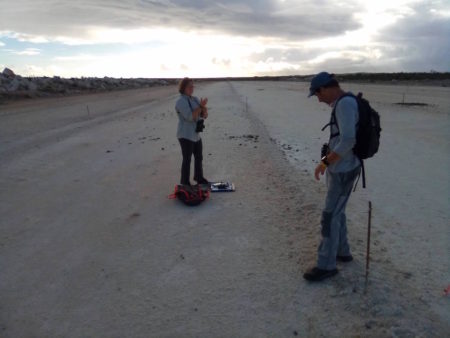
Back to the field work! During the first few days, we kicked up clouds of red dust as we walked from point to point to count the Barbuda Warbler. Then, there were a few unexpected challenges, some caused by the much-needed heavy rains we encountered (Antigua and Barbuda have been in a drought for several years). But folks were happy to pull us out of the resulting mud when we got stuck and we were able to complete our surveys despite several rain delays. The construction of the new airport meant that several points we had previously counted were now either on the runway or in the middle of the rock quarry supporting the new construction. Habitat loss and concerns about the impact the airport will have on the surrounding warblers are something that should be closely monitored into the future.
There was also good news. We observed warblers throughout the island in numbers roughly similar to the previous counts shortly after the hurricane. 71 of the 105 random points counted during the week included at least one Barbuda Warbler. Certainly, one of the reasons the Barbuda Warbler population is doing this well, following a direct hit by Irma, is simply the amount of habitat available on Barbuda. The small human population and communal land ownership laws on Barbuda have resulted in most of the island remaining in a wild state, providing the warbler and other life with ample habitat. This likely provides significant buffers to the impacts of natural disasters such as droughts and hurricanes. As that habitat decreases, however, with the developments that are sure to follow the opening of a new airport, the risks to the warbler and its long term survival will also increase.
While the warbler appears to be doing fairly well, the data are still being analyzed and any conjecture about the true population status at this time is based on our observations and not statistics. We will follow up this blog post with the population estimates once the numbers have been crunched (and we will also present our work at BirdsCaribbean’s 22nd International Conference in Guadeloupe). The data are now off to Dr. Frank Rivera-Milan (who led the team during the first visit) – he will be running the various models to produce a current population estimate.
All in all, it was a very busy week but we had a wonderful time. Counting birds, meeting new friends, and spending time on such a beautiful, mostly wild island is a special experience—I’m ready to go back !!!
Thank you to our Partners!
We thank our donors and supporters who made this trip a successful one. Firstly, many thanks are expressed to the U.S. Fish & Wildlife Service (Neotropical Migratory Bird Conservation Act Fund), Global Wildlife Conservation, and Mr. Lamont Brown for providing funding for these important surveys and also for the educational outreach in Barbuda. Sincere thanks to the Environmental Awareness Group (EAG) for assisting with the logistics, especially Ms. Arica Hill and Mr. Kelly Burton (Dept of Environment). Thanks to Fernando Simal (WILDCONSCIENCE), Joseph (Junior) Prosper, Natalya Lawrence, Shanna Challenger, and Sophie Punnett-Steele for tireless help with the field work. Thank you to Mr. John Mussington and Ms. Charlene Harris, principals at both the secondary and elementary schools in Barbuda, for affording us the opportunity to visit and speak with the students. Finally, we wish to thank the Barbuda Council and the Barbudan people who provided us with their assistance and support.
By Jeff Gerbracht, Lead Application Developer, eBird, Cornell Lab of Ornithology. For many years, Jeff has served as a volunteer facilitator at our BirdsCaribbean training workshops and assisted with a number of field survey and monitoring efforts.
Hover over each photo to see the caption or click on the first photo to see a slide show.












